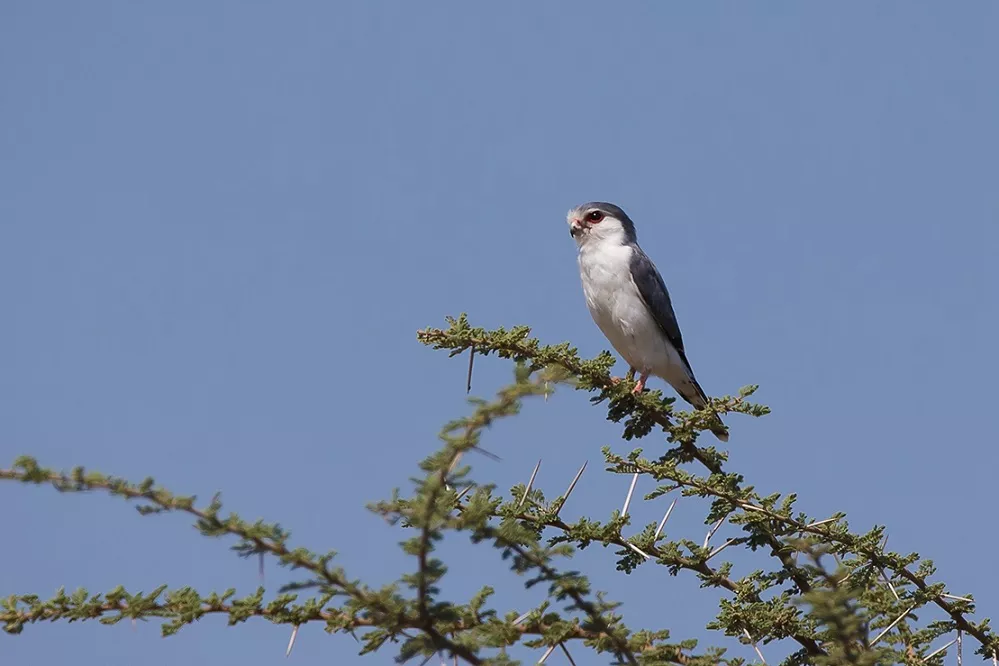Falcons are a family of birds of prey known for their speed, agility, and sharp talons. They come in many shapes and sizes, from the powerful and impressive peregrine falcon to the tiny and elusive pygmy falcon. The pygmy falcon, in fact, is the smallest falcon in the world.
Scientifically known as Polihierax semitorquatus, the pygmy falcon is found in parts of sub-Saharan Africa and is one of the smallest birds of prey in the world. The pygmy falcon is only about 6 inches (15 centimeters) long, and weighs less than 2 ounces (55 grams). It is about the same size as a sparrow, but with a much more impressive set of hunting skills.
Despite its small size, the pygmy falcon is a fierce hunter. It feeds primarily on insects and small rodents, and is known for its acrobatic flying and lightning-fast strikes. Like all falcons, the pygmy falcon has a hooked beak and sharp talons that it uses to catch and kill its prey. It is also incredibly agile in the air, and can maneuver with great speed and precision.
Despite its small size, the pygmy falcon is a fierce hunter and is known to take down prey much larger than itself. It preys on insects, small reptiles, rodents, and even small birds. Its diet varies depending on the location and availability of prey in its habitat.
One of the most interesting things about the pygmy falcon is its nesting habits. Unlike most other falcons, which build their nests high up in trees or on cliffs, the pygmy falcon nests in abandoned tree holes or in the abandoned nests of other birds. It is also known to nest in the abandoned nests of weaver birds, which are large, communal nests made of grass and twigs. and both male and female take turns incubating the eggs and feeding the chicks.
The pygmy falcon is not considered to be globally threatened, but it does face some local threats such as habitat loss and persecution from farmers who see it as a pest because it preys on birds such as weaver birds that damage crops.
In addition to the Pygmy Falcon, which is the smallest falcon, there are several falcons that are also considered smaller falcons.
- The Kestrel Falcon
The Kestrel falcon, also known as the European Kestrel or the Common Kestrel, is one of the smallest falcons in the world. This tiny bird measures just 21-31 cm (8-12 inches) long, with a wingspan of 55-80 cm (22-32 inches). With its distinctive red-brown plumage and black spots on its crown, the Kestrel is easy to spot in open habitats such as deserts, grasslands, and farmland.
Despite its diminutive size, the key is a formidable predator, Feeding on Small Mammam, Birds, and Insects. It utes a community, agility, and s Harp Talons to Capture its prey, which it typically consumes on the group. The Kestrel is A solitary bird that prefers to hunt during the day, especially in the early morning and late afternoon.
- American Kestrel (Falco sparverius):
The American Kestrel, also known as the Sparrow Hawk, is one of the smallest and most colorful falcons globally. Adults measure approximately 20-25 centimeters (8-10 inches) in length, with a wingspan of about 50-60 centimeters (20- 24 inches). Their petite size is complemented by a vibrant plumage, featuring a combination of rufous, blue, and white colors.
Like the European Kestrel, the American Kestrel feeds primarily on small mammals, birds, and insects, using its sharp talons and beak to capture and kill its prey. It is also a diurnal hunter that prefers to hunt from a perch or while flying, making It is a common sight in open habitats such as grasslands, meadows, and agricultural fields.
- The Nankeen Kestrel
The Nankeen Kestrel, also known as the Australian Kestrel, is a small falcon that is found throughout Australia and parts of Southeast Asia. It measures 25-35 cm (10-14 inches) long with a wingspan of 60-80 cm (24- 32 inches), making it slightly larger than the European and American Kestrels.
The Nankeen Kestrel is a versatile hunter that feeds on a variety of prey, including insects, small mammals, and birds. It is also a diurnal hunter that prefers to hunt from a perch or while flying over open habitats such as grasslands, wetlands, and farmland. Like other kestrels, the Nankeen Kestrel is recognized for its distinctive plumage, which includes a russet back, white underparts, and black spots on its crown.
In conclusion, the pygmy falcon is a fascinating and unique bird of prey that despite its small size, is a skilled and determined hunter. Its distinctive appearance and social behavior make it a favorite among bird watchers and photographers.


 Facebook
Facebook  Instagram
Instagram  Youtube
Youtube 